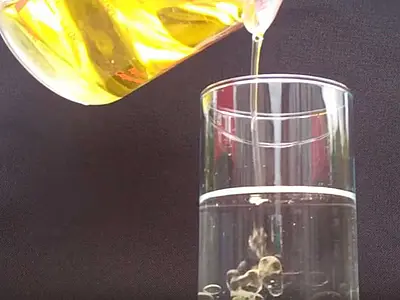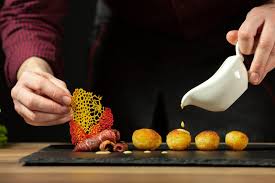Anúncios
Delve into the fascinating world of food chemistry with this engaging exploration into the savory secrets behind your favorite meals. This comprehensive study will not only satiate your curiosity, but also titillate your taste buds. If you’ve ever wondered why your beloved cheeseburger tastes so divine, or why that piece of chocolate cake seems to melt in your mouth, you’re about to embark on a delectable journey that will unravel the mouthwatering mysteries hidden within the ingredients of these culinary masterpieces. 🍔🍰
In this detailed exploration, we’ll uncover how the intricate science of molecular gastronomy shapes our experiences with the foods we love. From the sizzling reaction that occurs when a steak hits a hot grill, to the creamy delight that is a perfectly balanced custard, every step of the cooking process involves a fascinating interplay of chemistry and flavor. In essence, each bite we take is a testament to the science of taste. 🥩🍮
Anúncios
Get ready to traverse the exciting landscape of flavor profiles, reactions, and processes that make our food not only essential for life, but a source of immense pleasure. The journey is set to be as enriching as it is tasty, and by the end, you’ll have gained a whole new appreciation for the complex symphony of science that plays out in every dish. So, tie on your apron, and prepare to discover the delicious secrets that make your favorite foods so irresistible! 🍽️
The Chemical Reactions Behind Your Favorite Foods
When it comes to enjoying a delicious meal, most of us focus on taste, texture, and aroma. But behind every bite lies a symphony of chemical reactions that transform simple ingredients into mouthwatering experiences. Understanding these processes not only enhances our appreciation of food but also empowers us to cook with greater precision and creativity.
Anúncios
The Maillard Reaction: Browning That Brings Flavor
One of the most famous and flavorful chemical reactions in cooking is the Maillard reaction. Named after French chemist Louis-Camille Maillard, this process occurs when amino acids and reducing sugars interact under heat, typically above 140°C (284°F). It’s responsible for the golden crust on baked bread, the sear on a steak, and the rich aroma of roasted coffee or grilled vegetables.
What makes this reaction so special is the complexity it creates. Hundreds of new flavor compounds emerge, contributing to the savory, umami-rich taste that’s often associated with well-cooked food. Without the Maillard reaction, our meals would lack depth, richness, and that irresistible “cooked” flavor.
Caramelization: Sweet Science in Action
Caramelization is another key reaction, especially in sweets and desserts. Unlike the Maillard reaction, it involves only sugars. When heated, sugar molecules break down and recombine to form new compounds, resulting in a deep brown color and complex flavors ranging from nutty and buttery to bitter and toasty.
Caramelization begins at around 170°C (338°F), and its results are evident in crème brûlée’s crust, caramel sauce, and the golden color of sautéed onions. Timing and temperature control are crucial here—too much heat can lead to bitterness, while too little won’t create the desired flavor or color.
Emulsification: Blending Oil and Water
Many of your favorite creamy dishes rely on a process called emulsification. This happens when two immiscible liquids, like oil and water, are forced to combine into a stable mixture. Mayonnaise, hollandaise sauce, and vinaigrettes are classic examples.
In culinary emulsions, ingredients like egg yolk or mustard act as emulsifiers, stabilizing the mixture by reducing the surface tension between the liquids. The result is a smooth, uniform texture that enhances both mouthfeel and taste.

Acid-Base Reactions: Balancing Flavor and Color
The acidity or alkalinity (pH) of ingredients plays a significant role in cooking. Acid-base reactions can influence both the appearance and flavor of a dish. For example, red cabbage turns bluish-green in an alkaline environment but stays vividly purple in acidic conditions. Similarly, baking soda (a base) reacts with acidic ingredients like vinegar or buttermilk to produce carbon dioxide, helping baked goods rise.
Balancing acids—like lemon juice, vinegar, or tomato—with fats and sugars is fundamental in creating well-rounded flavors. This chemical equilibrium gives dishes brightness, cuts through richness, and elevates the overall taste.
Fermentation: Microbial Magic
Fermentation is the result of beneficial microbes—such as yeast and bacteria—breaking down sugars into gases, acids, or alcohols. The most common example is yeast fermentation, which produces carbon dioxide in bread dough, giving it its airy texture.
Lactic acid fermentation, on the other hand, is responsible for the tangy flavor of yogurt, sauerkraut, kimchi, and sourdough. These chemical changes not only improve flavor and texture but also enhance shelf life and nutritional value, adding probiotics and essential enzymes.
The Maillard Reaction
Let’s start with the Maillard Reaction. Named after Louis-Camille Maillard, a French chemist who first studied it in the early 20th century, this reaction is responsible for browning food when it’s cooked. When the amino acids and sugars in food are heated, they transform, creating new flavor compounds. This reaction is responsible for the delicious flavors and smells of freshly baked bread, grilled steak, and roasted coffee beans. In fact, without the Maillard Reaction, many of our favorite foods would be bland and unappetizing.
Emulsions in Food
Emulsions are another critical aspect of food chemistry. These mixtures of two liquids that typically do not mix—such as oil and water—are fundamental to the texture, flavor, and stability of many beloved culinary creations. An emulsion is formed when one liquid is dispersed into another in the form of tiny droplets, which are stabilized by mechanical force or the addition of emulsifying agents.

One of the most common examples of emulsions is found in salad dressings. When you vigorously shake or whisk together oil and vinegar, the mixture temporarily becomes uniform as oil droplets become suspended within the aqueous solution. However, without an emulsifier, this mixture will eventually separate. This is where substances like mustard, honey, or egg yolks come in—they contain natural emulsifiers that help stabilize the emulsion, allowing it to remain uniform for longer periods.
Mayonnaise is a prime example of a stable emulsion. It is made by slowly incorporating oil into egg yolk while continuously whisking. The lecithin in the yolk acts as a powerful emulsifier, keeping the oil droplets evenly distributed and giving mayonnaise its smooth, creamy consistency. Butter is another emulsion, though it is a water-in-fat emulsion as opposed to most dressings and sauces, which are fat-in-water emulsions.
The science behind emulsions becomes even more fascinating when considering how emulsions influence the sensory properties of food. They affect not only the texture and mouthfeel but also the way flavors are released and perceived. For example, a well-emulsified sauce feels rich and luxurious on the tongue, enhancing the perception of umami and overall flavor satisfaction.
Chefs and food scientists alike exploit the properties of emulsions to develop novel textures and taste experiences, particularly in the field of molecular gastronomy. High-tech emulsification techniques, such as using rotor-stator devices or ultrasonic homogenizers, allow for the creation of ultra-stable emulsions with unique properties, expanding the boundaries of modern cuisine.
In essence, emulsions are more than just physical mixtures; they are complex systems that exemplify the intersection of chemistry and culinary artistry. Understanding how emulsions work not only elevates cooking techniques but also deepens our appreciation for the scientific sophistication behind even the simplest dishes.
The Role of Acidity and Alkalinity in Food
Another important chemical reaction in cooking involves the pH level, which measures how acidic or alkaline a substance is. The pH scale ranges from 0 to 14, with lower numbers indicating acidity, higher numbers indicating alkalinity, and 7 being neutral. This seemingly simple concept has a profound influence on how food tastes, looks, and even feels in the mouth.
Acidity or alkalinity can dramatically affect the color of fruits and vegetables. For example, green vegetables such as spinach, broccoli, or green beans contain chlorophyll, a pigment that is sensitive to pH changes. When cooked in water that is too alkaline, these vibrant greens can quickly turn a dull olive-gray color. Conversely, an acidic environment—created by adding a splash of lemon juice or vinegar—can help preserve or even enhance their bright, fresh appearance during cooking.
In addition to color, pH also plays a major role in flavor development. Acidic ingredients, such as citrus juices, vinegar, and tomatoes, add brightness and balance to dishes, cutting through richness and enhancing overall taste. Alkaline substances, like baking soda, can have the opposite effect—softening flavors, altering textures, and affecting browning reactions.
Speaking of baking soda, it’s often used in recipes to alter pH and improve texture. For instance, in baked goods, a slightly alkaline environment can help with browning through the Maillard reaction, while also giving cakes and cookies a tender crumb. However, too much alkalinity can leave a soapy or metallic taste, so precise measurements are crucial.
Some classic cooking techniques rely heavily on pH manipulation. Pickling, for instance, involves increasing acidity to preserve food and create sharp, tangy flavors. Marinating meat in acidic liquids like vinegar or citrus juice can tenderize it by breaking down proteins.
Understanding and controlling pH in cooking is a powerful tool. It allows chefs and home cooks alike to maintain color, enhance flavor, and manipulate texture, leading to more delicious and visually appealing dishes. By paying attention to this subtle yet vital aspect of food chemistry, anyone can elevate their culinary skills and unlock the full potential of their ingredients.
Fermentation: A Delicious Transformation
Fermentation is a type of controlled decomposition that uses bacteria, yeast, or other microorganisms to convert sugars into other products like alcohol, gas, or acid. This process is used to create a wide range of foods and beverages, including wine, beer, yogurt, sourdough bread, kimchi, and sauerkraut. The microorganisms used in fermentation not only help preserve food, but they also contribute to its taste, texture, and nutritional value.

Enzymes at Work in Food
Enzymes also play a vital role in baking, where they help break down starches and proteins in flour to improve dough texture and flavor. In meat, enzymes contribute to tenderization during aging or marination. Additionally, enzymes are used in brewing and winemaking to break down complex sugars and aid fermentation. By understanding how enzymes function, chefs and food scientists can manipulate these reactions to achieve desired textures, flavors, and preservation outcomes. Their precise control is essential not only for maintaining food quality but also for enhancing nutritional value and safety in both traditional and modern culinary practices.
The Amazing Transformation of Starches
Starch, a carbohydrate found in many foods like potatoes, pasta, and rice, undergoes a transformation when it’s heated in the presence of water. This process, known as gelatinization, causes the starch to swell and absorb water, thickening the food. It’s what gives risotto its creamy texture and helps thicken sauces and gravies.
Conclusion
In conclusion, “Unlocking the Delicious Secrets: Exploring the Chemistry Behind Your Favorite Foods” reveals an exciting intersection between food and science. The article brilliantly illustrates how chemistry plays a pivotal role in our everyday eating experiences, transforming our understanding of everyday food items. From the Maillard reaction responsible for the delightful brown crust on freshly baked bread, to the science behind the mouthwatering aroma of coffee, each section of the article opens up new dimensions of culinary knowledge.
Moreover, this article doesn’t just satisfy our intellectual curiosity; it also offers practical insights. Understanding food chemistry can empower us to make better food choices, enhance our cooking skills, and even intensify our appreciation of the food we consume.
In essence, by delving into the chemistry of our favorite foods, we can unlock hidden layers of delicious secrets waiting to be explored. So the next time you bite into your favorite meal or sip your morning coffee, remember the complex chemical symphony playing out behind the scenes, making each bite and sip a delightful sensory experience. Whether you’re a food lover or a chemistry enthusiast, the intersection of these two worlds promises a feast of knowledge and flavors.

